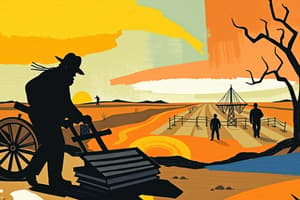Podcast
Questions and Answers
What was the Great Depression?
What was the Great Depression?
This depression of the 1930's lasted far longer, caused more business failures and unemployment, and affected more people than any other preceding period of hard times.
What happened on Black Thursday, October 24?
What happened on Black Thursday, October 24?
There was an unprecedented volume of selling on Wall Street, and stock prices plunged.
What occurred on Black Tuesday, October 29?
What occurred on Black Tuesday, October 29?
The bottom fell out of the market as millions of panicky investors ordered their brokers to sell when there were practically no buyers.
What is the Dow Jones Index?
What is the Dow Jones Index?
Which of the following were causes of the Great Depression? (Select all that apply)
Which of the following were causes of the Great Depression? (Select all that apply)
What does 'buying on margin' refer to?
What does 'buying on margin' refer to?
What were the effects of the Great Depression?
What were the effects of the Great Depression?
Who was Herbert Hoover?
Who was Herbert Hoover?
What is the significance of the Hawley-Smoot Tariff?
What is the significance of the Hawley-Smoot Tariff?
What was the purpose of the Emergency Banking Relief Act?
What was the purpose of the Emergency Banking Relief Act?
What did the Social Security program establish?
What did the Social Security program establish?
What was the role of the National Labor Relations Board?
What was the role of the National Labor Relations Board?
What was the goal of the Fair Labor Standards Act?
What was the goal of the Fair Labor Standards Act?
Who was A. Philip Randolph?
Who was A. Philip Randolph?
What did the Indian Reorganization Act achieve?
What did the Indian Reorganization Act achieve?
Flashcards are hidden until you start studying
Study Notes
Great Depression Overview
- The Great Depression of the 1930s was the longest and most severe economic downturn in history, impacting both the middle and working classes.
- Major causes included unequal income distribution, stock market speculation, and excessive credit use.
Black Thursday & Black Tuesday
- Black Thursday (October 24): Marked by huge selling on Wall Street resulting in a rapid decline in stock prices. Bankers attempted to stabilize the market by buying stocks but only succeeded temporarily.
- Black Tuesday (October 29): A massive sell-off occurred as panic ensued among investors, leading to a complete market collapse.
Economic Indicators
- The Dow Jones Index plummeted from 381 to 198, eventually bottoming out at 41.
- The U.S. Gross National Product fell dramatically from $104 billion to $56 billion in four years, with national income decreasing by over 50%.
Causes of Economic Collapse
- Unequal income distribution allowed the wealthiest 5% to earn over 33% of total income, limiting consumer purchasing power.
- The practice of buying stocks on margin encouraged risky investments without adequate capital upfront.
- Overproduction combined with stagnant wages meant workers could not purchase the goods produced, exacerbating economic woes.
- Weak agricultural conditions persisted due to low prices and rising debt from post-World War I impacts.
Government Response
- Federal policies included the Hawley-Smoot Tariff, raising import taxes to protect U.S. industries while harming agricultural exports.
- Measures initiated by President Hoover, like the Reconstruction Finance Corporation, aimed to stabilize businesses and encourage economic recovery.
Notable Figures
- Herbert Hoover: The sitting president during the crash, optimistic about the economy's quick recovery.
- Franklin D. Roosevelt: Elected in 1932, he promised a "New Deal" and enacted numerous reforms to combat the Great Depression.
Key Legislative Actions
- The Emergency Banking Relief Act aimed to restore public confidence in banks by re-opening sound institutions.
- The Federal Deposit Insurance Corporation guaranteed bank deposits, providing a safety net for savers.
- The Social Security Act established a federal insurance program for the elderly funded by taxes from workers and employers.
Social Welfare and Job Creation
- New Deal programs like the Civilian Conservation Corps provided jobs for young men, while the Works Progress Administration aimed to employ a wide range of workers in various public projects.
- The National Youth Administration targeted part-time jobs for students to encourage education continuation.
Labor Rights and Economic Recovery
- The National Labor Relations Act (Wagner Act) protected workers’ rights to unionize and bargain collectively.
- The Fair Labor Standards Act set minimum wage and restricted child labor, reinforcing protections for workers.
Cultural Impact
- John Steinbeck’s "The Grapes of Wrath" depicted the struggles of displaced families during the Dust Bowl and Great Depression.
- Influential African American figures like Eleanor Roosevelt and Mary McLeod Bethune advanced social causes and fought for civil rights during this turbulent period.
Court Challenges
- Several New Deal measures faced legal scrutiny, leading to landmark Supreme Court cases such as Schechter vs. U.S. and Butler vs. U.S., which deemed certain acts unconstitutional, particularly concerning agricultural policies.
Continuing Challenges
- The Depression mentality fostered enduring feelings of insecurity and economic anxiety among the population, impacting social attitudes long after the economy began to recover.
Studying That Suits You
Use AI to generate personalized quizzes and flashcards to suit your learning preferences.




